Project Management Methodologies and Continuous Improvement Plan
VerifiedAdded on 2020/03/16
|13
|3817
|42
Project
AI Summary
This project explores project management methodologies and their application in a continuous improvement plan for Latino Engineering. It begins with an introduction to continuous improvement, emphasizing the PDCA cycle and the use of a fishbone diagram to identify root causes. The project then outlines a continuous improvement plan using a POTI diagram, addressing processes, organization, technology, and information. A textual overview details the use of 7QC tools (stratification, histogram, check sheet, fishbone diagram, Pareto chart, control chart, and scatter diagram) to analyze quality issues. The Six Sigma approach, utilizing the DMAIC framework, is proposed to address critical success factors and implement the plan. The project concludes with a Gantt chart illustrating the implementation timeline and a summary of the findings, offering a comprehensive approach to improve processes, quality, and customer satisfaction at Latino Engineering.
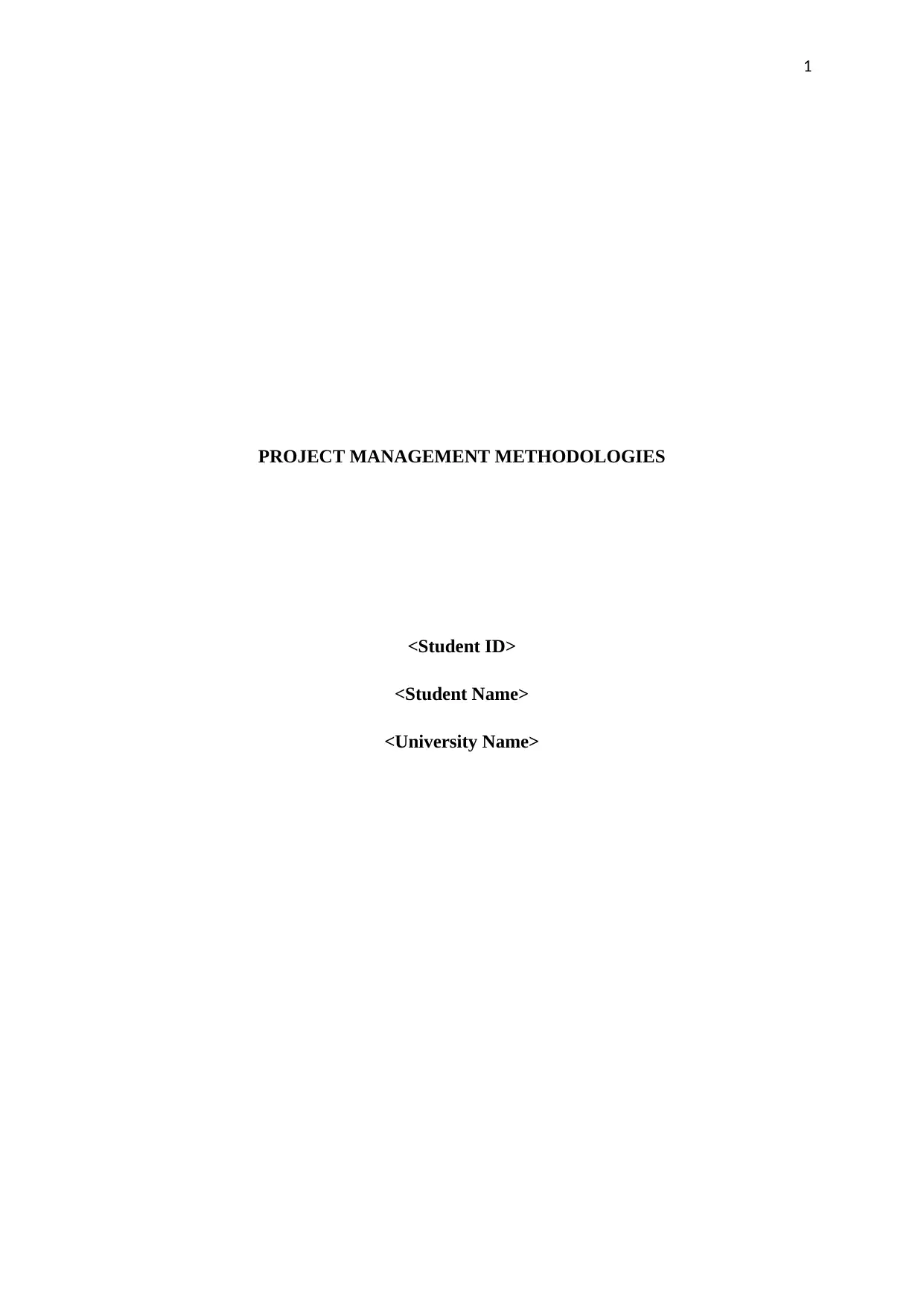
1
PROJECT MANAGEMENT METHODOLOGIES
<Student ID>
<Student Name>
<University Name>
PROJECT MANAGEMENT METHODOLOGIES
<Student ID>
<Student Name>
<University Name>
Paraphrase This Document
Need a fresh take? Get an instant paraphrase of this document with our AI Paraphraser
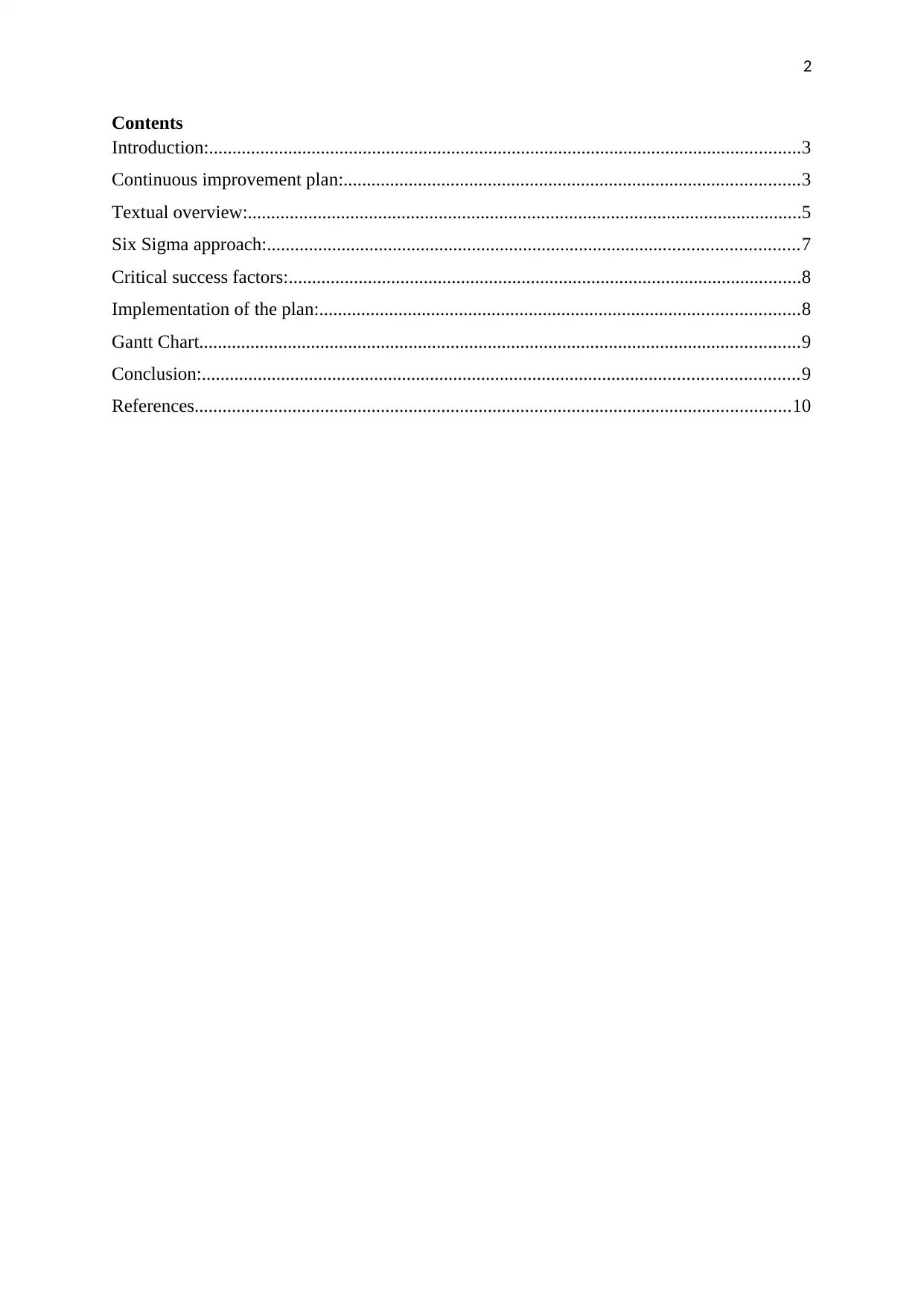
2
Contents
Introduction:...............................................................................................................................3
Continuous improvement plan:..................................................................................................3
Textual overview:.......................................................................................................................5
Six Sigma approach:..................................................................................................................7
Critical success factors:..............................................................................................................8
Implementation of the plan:.......................................................................................................8
Gantt Chart.................................................................................................................................9
Conclusion:................................................................................................................................9
References................................................................................................................................10
Contents
Introduction:...............................................................................................................................3
Continuous improvement plan:..................................................................................................3
Textual overview:.......................................................................................................................5
Six Sigma approach:..................................................................................................................7
Critical success factors:..............................................................................................................8
Implementation of the plan:.......................................................................................................8
Gantt Chart.................................................................................................................................9
Conclusion:................................................................................................................................9
References................................................................................................................................10
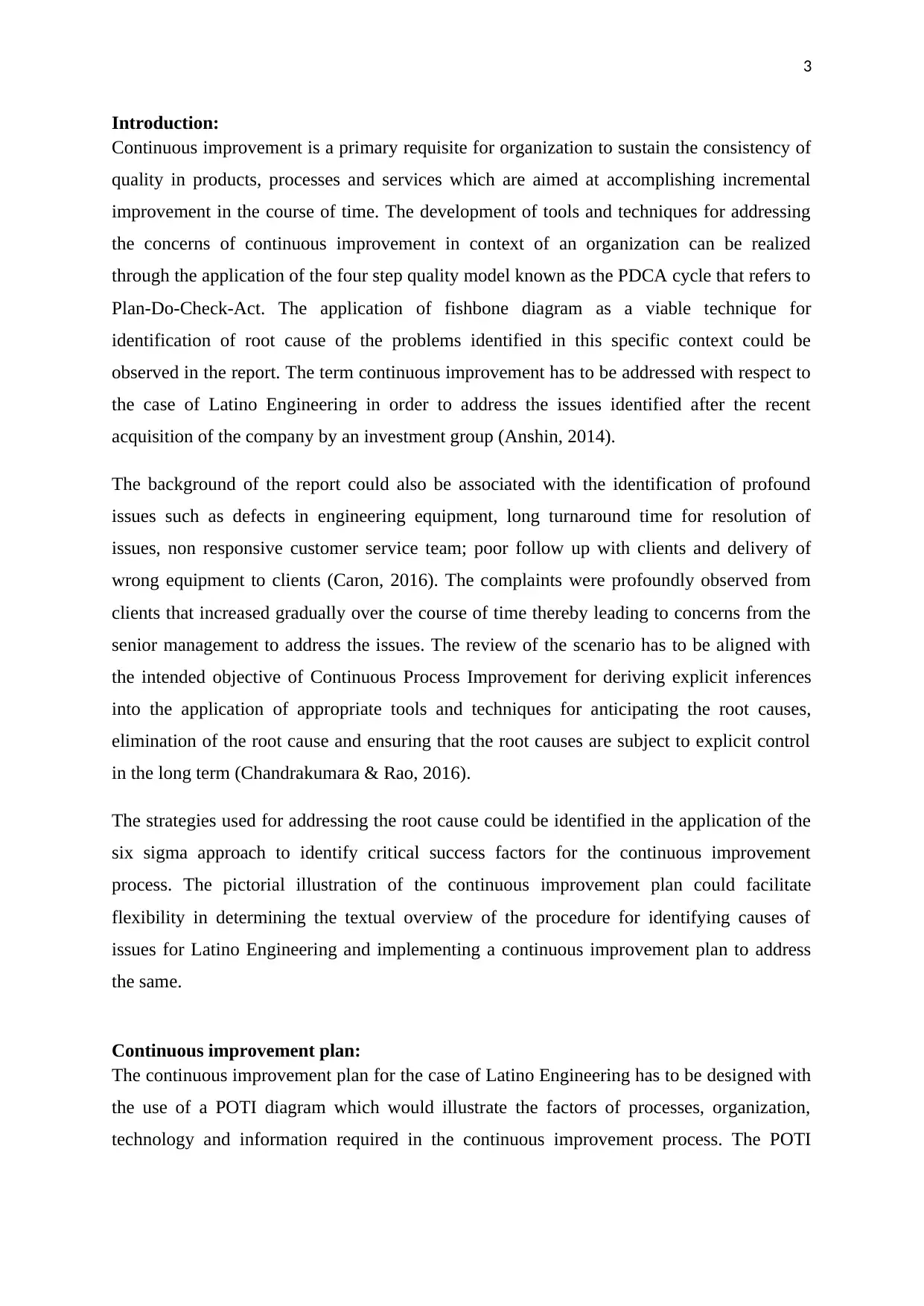
3
Introduction:
Continuous improvement is a primary requisite for organization to sustain the consistency of
quality in products, processes and services which are aimed at accomplishing incremental
improvement in the course of time. The development of tools and techniques for addressing
the concerns of continuous improvement in context of an organization can be realized
through the application of the four step quality model known as the PDCA cycle that refers to
Plan-Do-Check-Act. The application of fishbone diagram as a viable technique for
identification of root cause of the problems identified in this specific context could be
observed in the report. The term continuous improvement has to be addressed with respect to
the case of Latino Engineering in order to address the issues identified after the recent
acquisition of the company by an investment group (Anshin, 2014).
The background of the report could also be associated with the identification of profound
issues such as defects in engineering equipment, long turnaround time for resolution of
issues, non responsive customer service team; poor follow up with clients and delivery of
wrong equipment to clients (Caron, 2016). The complaints were profoundly observed from
clients that increased gradually over the course of time thereby leading to concerns from the
senior management to address the issues. The review of the scenario has to be aligned with
the intended objective of Continuous Process Improvement for deriving explicit inferences
into the application of appropriate tools and techniques for anticipating the root causes,
elimination of the root cause and ensuring that the root causes are subject to explicit control
in the long term (Chandrakumara & Rao, 2016).
The strategies used for addressing the root cause could be identified in the application of the
six sigma approach to identify critical success factors for the continuous improvement
process. The pictorial illustration of the continuous improvement plan could facilitate
flexibility in determining the textual overview of the procedure for identifying causes of
issues for Latino Engineering and implementing a continuous improvement plan to address
the same.
Continuous improvement plan:
The continuous improvement plan for the case of Latino Engineering has to be designed with
the use of a POTI diagram which would illustrate the factors of processes, organization,
technology and information required in the continuous improvement process. The POTI
Introduction:
Continuous improvement is a primary requisite for organization to sustain the consistency of
quality in products, processes and services which are aimed at accomplishing incremental
improvement in the course of time. The development of tools and techniques for addressing
the concerns of continuous improvement in context of an organization can be realized
through the application of the four step quality model known as the PDCA cycle that refers to
Plan-Do-Check-Act. The application of fishbone diagram as a viable technique for
identification of root cause of the problems identified in this specific context could be
observed in the report. The term continuous improvement has to be addressed with respect to
the case of Latino Engineering in order to address the issues identified after the recent
acquisition of the company by an investment group (Anshin, 2014).
The background of the report could also be associated with the identification of profound
issues such as defects in engineering equipment, long turnaround time for resolution of
issues, non responsive customer service team; poor follow up with clients and delivery of
wrong equipment to clients (Caron, 2016). The complaints were profoundly observed from
clients that increased gradually over the course of time thereby leading to concerns from the
senior management to address the issues. The review of the scenario has to be aligned with
the intended objective of Continuous Process Improvement for deriving explicit inferences
into the application of appropriate tools and techniques for anticipating the root causes,
elimination of the root cause and ensuring that the root causes are subject to explicit control
in the long term (Chandrakumara & Rao, 2016).
The strategies used for addressing the root cause could be identified in the application of the
six sigma approach to identify critical success factors for the continuous improvement
process. The pictorial illustration of the continuous improvement plan could facilitate
flexibility in determining the textual overview of the procedure for identifying causes of
issues for Latino Engineering and implementing a continuous improvement plan to address
the same.
Continuous improvement plan:
The continuous improvement plan for the case of Latino Engineering has to be designed with
the use of a POTI diagram which would illustrate the factors of processes, organization,
technology and information required in the continuous improvement process. The POTI
⊘ This is a preview!⊘
Do you want full access?
Subscribe today to unlock all pages.

Trusted by 1+ million students worldwide
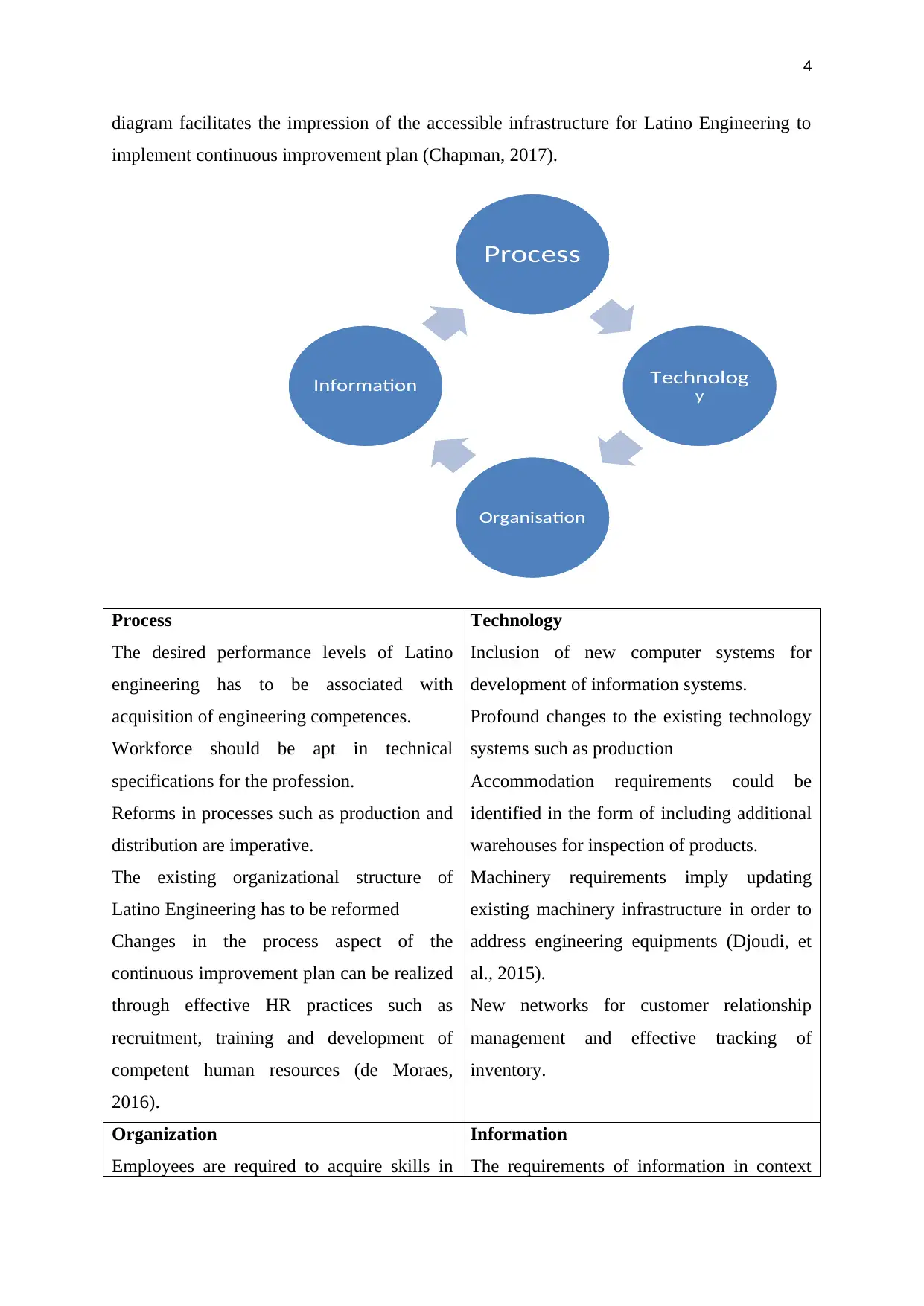
4
diagram facilitates the impression of the accessible infrastructure for Latino Engineering to
implement continuous improvement plan (Chapman, 2017).
Process
The desired performance levels of Latino
engineering has to be associated with
acquisition of engineering competences.
Workforce should be apt in technical
specifications for the profession.
Reforms in processes such as production and
distribution are imperative.
The existing organizational structure of
Latino Engineering has to be reformed
Changes in the process aspect of the
continuous improvement plan can be realized
through effective HR practices such as
recruitment, training and development of
competent human resources (de Moraes,
2016).
Technology
Inclusion of new computer systems for
development of information systems.
Profound changes to the existing technology
systems such as production
Accommodation requirements could be
identified in the form of including additional
warehouses for inspection of products.
Machinery requirements imply updating
existing machinery infrastructure in order to
address engineering equipments (Djoudi, et
al., 2015).
New networks for customer relationship
management and effective tracking of
inventory.
Organization
Employees are required to acquire skills in
Information
The requirements of information in context
Process
Technolog
y
Organisation
Information
diagram facilitates the impression of the accessible infrastructure for Latino Engineering to
implement continuous improvement plan (Chapman, 2017).
Process
The desired performance levels of Latino
engineering has to be associated with
acquisition of engineering competences.
Workforce should be apt in technical
specifications for the profession.
Reforms in processes such as production and
distribution are imperative.
The existing organizational structure of
Latino Engineering has to be reformed
Changes in the process aspect of the
continuous improvement plan can be realized
through effective HR practices such as
recruitment, training and development of
competent human resources (de Moraes,
2016).
Technology
Inclusion of new computer systems for
development of information systems.
Profound changes to the existing technology
systems such as production
Accommodation requirements could be
identified in the form of including additional
warehouses for inspection of products.
Machinery requirements imply updating
existing machinery infrastructure in order to
address engineering equipments (Djoudi, et
al., 2015).
New networks for customer relationship
management and effective tracking of
inventory.
Organization
Employees are required to acquire skills in
Information
The requirements of information in context
Process
Technolog
y
Organisation
Information
Paraphrase This Document
Need a fresh take? Get an instant paraphrase of this document with our AI Paraphraser
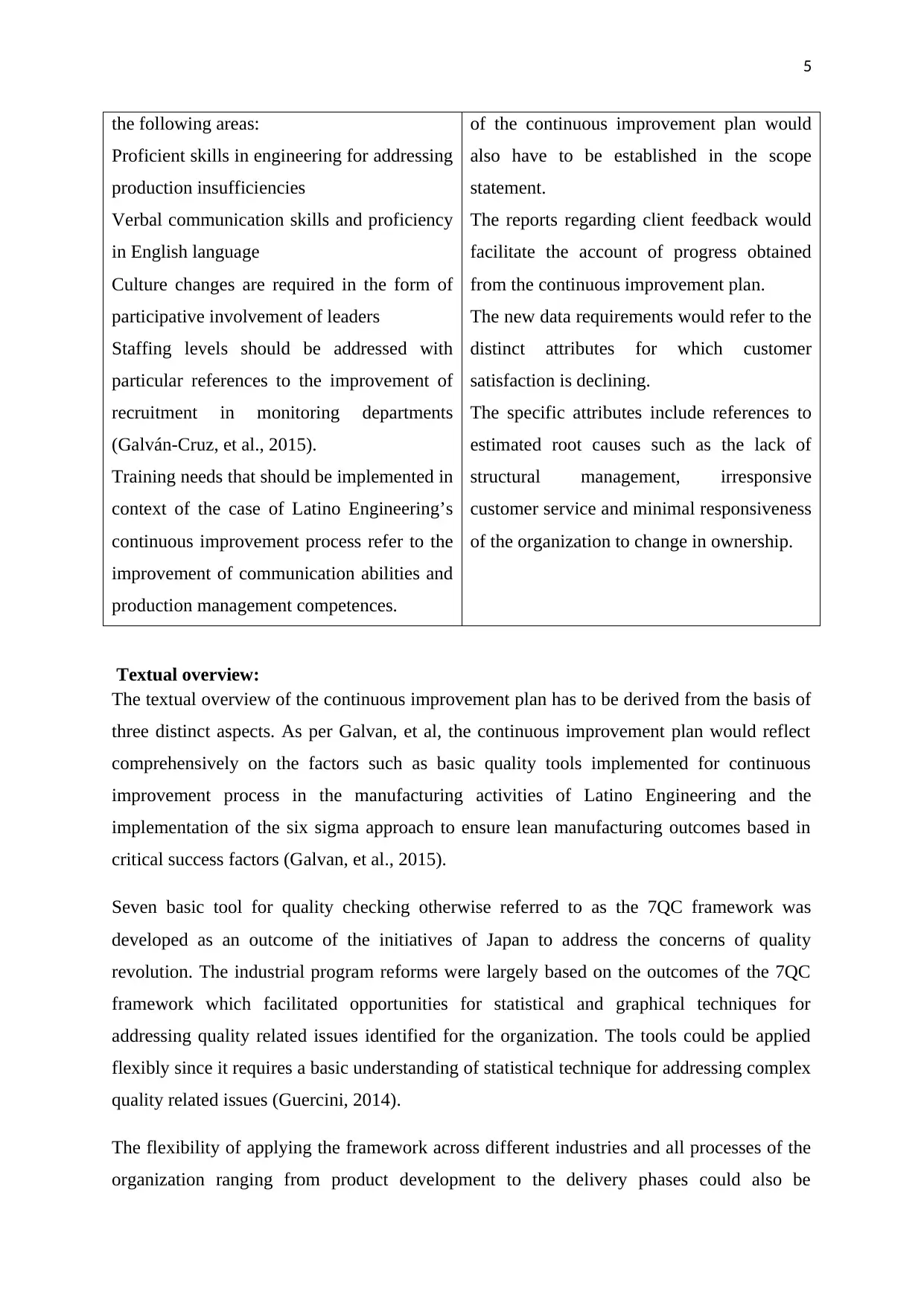
5
the following areas:
Proficient skills in engineering for addressing
production insufficiencies
Verbal communication skills and proficiency
in English language
Culture changes are required in the form of
participative involvement of leaders
Staffing levels should be addressed with
particular references to the improvement of
recruitment in monitoring departments
(Galván-Cruz, et al., 2015).
Training needs that should be implemented in
context of the case of Latino Engineering’s
continuous improvement process refer to the
improvement of communication abilities and
production management competences.
of the continuous improvement plan would
also have to be established in the scope
statement.
The reports regarding client feedback would
facilitate the account of progress obtained
from the continuous improvement plan.
The new data requirements would refer to the
distinct attributes for which customer
satisfaction is declining.
The specific attributes include references to
estimated root causes such as the lack of
structural management, irresponsive
customer service and minimal responsiveness
of the organization to change in ownership.
Textual overview:
The textual overview of the continuous improvement plan has to be derived from the basis of
three distinct aspects. As per Galvan, et al, the continuous improvement plan would reflect
comprehensively on the factors such as basic quality tools implemented for continuous
improvement process in the manufacturing activities of Latino Engineering and the
implementation of the six sigma approach to ensure lean manufacturing outcomes based in
critical success factors (Galvan, et al., 2015).
Seven basic tool for quality checking otherwise referred to as the 7QC framework was
developed as an outcome of the initiatives of Japan to address the concerns of quality
revolution. The industrial program reforms were largely based on the outcomes of the 7QC
framework which facilitated opportunities for statistical and graphical techniques for
addressing quality related issues identified for the organization. The tools could be applied
flexibly since it requires a basic understanding of statistical technique for addressing complex
quality related issues (Guercini, 2014).
The flexibility of applying the framework across different industries and all processes of the
organization ranging from product development to the delivery phases could also be
the following areas:
Proficient skills in engineering for addressing
production insufficiencies
Verbal communication skills and proficiency
in English language
Culture changes are required in the form of
participative involvement of leaders
Staffing levels should be addressed with
particular references to the improvement of
recruitment in monitoring departments
(Galván-Cruz, et al., 2015).
Training needs that should be implemented in
context of the case of Latino Engineering’s
continuous improvement process refer to the
improvement of communication abilities and
production management competences.
of the continuous improvement plan would
also have to be established in the scope
statement.
The reports regarding client feedback would
facilitate the account of progress obtained
from the continuous improvement plan.
The new data requirements would refer to the
distinct attributes for which customer
satisfaction is declining.
The specific attributes include references to
estimated root causes such as the lack of
structural management, irresponsive
customer service and minimal responsiveness
of the organization to change in ownership.
Textual overview:
The textual overview of the continuous improvement plan has to be derived from the basis of
three distinct aspects. As per Galvan, et al, the continuous improvement plan would reflect
comprehensively on the factors such as basic quality tools implemented for continuous
improvement process in the manufacturing activities of Latino Engineering and the
implementation of the six sigma approach to ensure lean manufacturing outcomes based in
critical success factors (Galvan, et al., 2015).
Seven basic tool for quality checking otherwise referred to as the 7QC framework was
developed as an outcome of the initiatives of Japan to address the concerns of quality
revolution. The industrial program reforms were largely based on the outcomes of the 7QC
framework which facilitated opportunities for statistical and graphical techniques for
addressing quality related issues identified for the organization. The tools could be applied
flexibly since it requires a basic understanding of statistical technique for addressing complex
quality related issues (Guercini, 2014).
The flexibility of applying the framework across different industries and all processes of the
organization ranging from product development to the delivery phases could also be
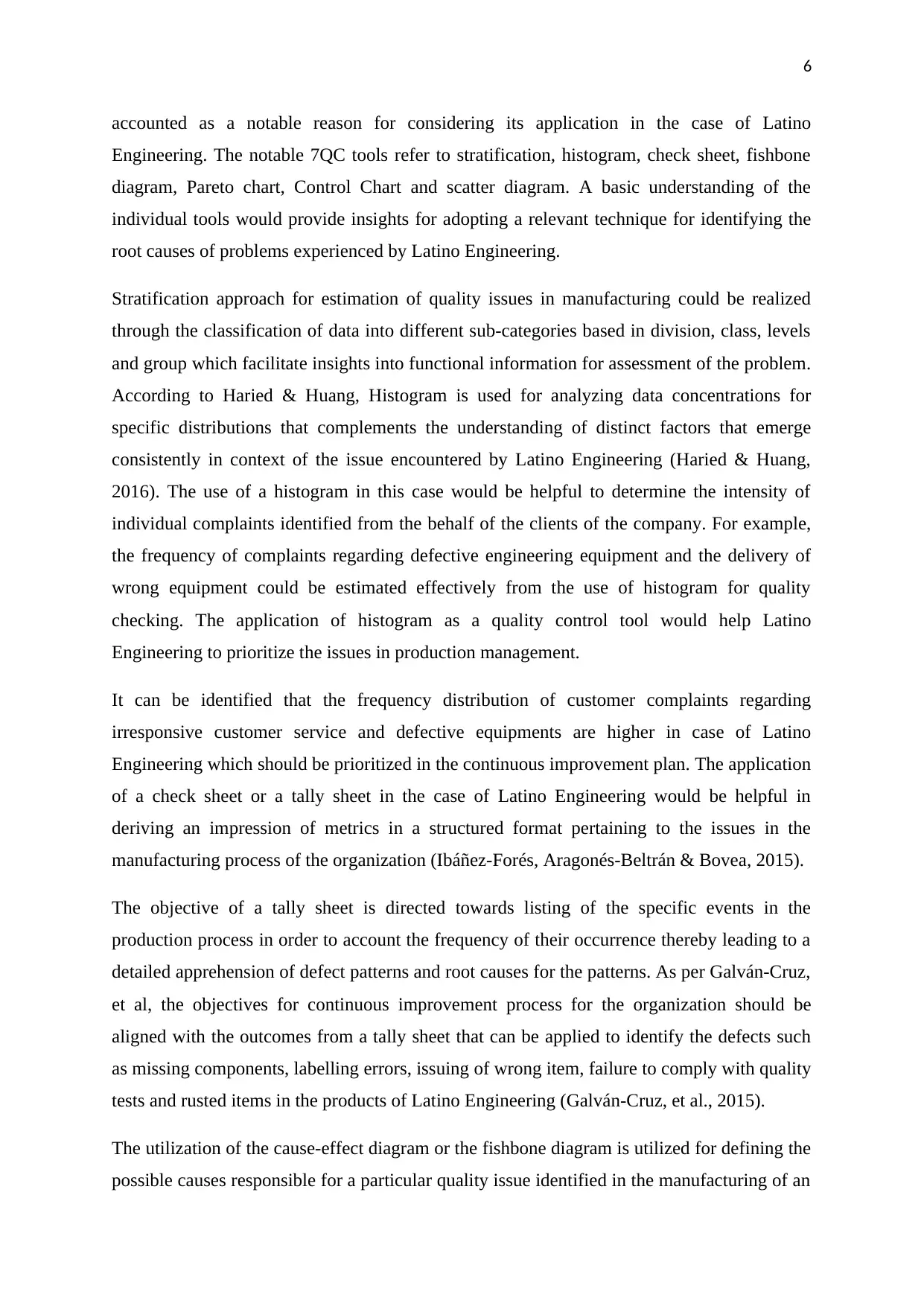
6
accounted as a notable reason for considering its application in the case of Latino
Engineering. The notable 7QC tools refer to stratification, histogram, check sheet, fishbone
diagram, Pareto chart, Control Chart and scatter diagram. A basic understanding of the
individual tools would provide insights for adopting a relevant technique for identifying the
root causes of problems experienced by Latino Engineering.
Stratification approach for estimation of quality issues in manufacturing could be realized
through the classification of data into different sub-categories based in division, class, levels
and group which facilitate insights into functional information for assessment of the problem.
According to Haried & Huang, Histogram is used for analyzing data concentrations for
specific distributions that complements the understanding of distinct factors that emerge
consistently in context of the issue encountered by Latino Engineering (Haried & Huang,
2016). The use of a histogram in this case would be helpful to determine the intensity of
individual complaints identified from the behalf of the clients of the company. For example,
the frequency of complaints regarding defective engineering equipment and the delivery of
wrong equipment could be estimated effectively from the use of histogram for quality
checking. The application of histogram as a quality control tool would help Latino
Engineering to prioritize the issues in production management.
It can be identified that the frequency distribution of customer complaints regarding
irresponsive customer service and defective equipments are higher in case of Latino
Engineering which should be prioritized in the continuous improvement plan. The application
of a check sheet or a tally sheet in the case of Latino Engineering would be helpful in
deriving an impression of metrics in a structured format pertaining to the issues in the
manufacturing process of the organization (Ibáñez-Forés, Aragonés-Beltrán & Bovea, 2015).
The objective of a tally sheet is directed towards listing of the specific events in the
production process in order to account the frequency of their occurrence thereby leading to a
detailed apprehension of defect patterns and root causes for the patterns. As per Galván-Cruz,
et al, the objectives for continuous improvement process for the organization should be
aligned with the outcomes from a tally sheet that can be applied to identify the defects such
as missing components, labelling errors, issuing of wrong item, failure to comply with quality
tests and rusted items in the products of Latino Engineering (Galván-Cruz, et al., 2015).
The utilization of the cause-effect diagram or the fishbone diagram is utilized for defining the
possible causes responsible for a particular quality issue identified in the manufacturing of an
accounted as a notable reason for considering its application in the case of Latino
Engineering. The notable 7QC tools refer to stratification, histogram, check sheet, fishbone
diagram, Pareto chart, Control Chart and scatter diagram. A basic understanding of the
individual tools would provide insights for adopting a relevant technique for identifying the
root causes of problems experienced by Latino Engineering.
Stratification approach for estimation of quality issues in manufacturing could be realized
through the classification of data into different sub-categories based in division, class, levels
and group which facilitate insights into functional information for assessment of the problem.
According to Haried & Huang, Histogram is used for analyzing data concentrations for
specific distributions that complements the understanding of distinct factors that emerge
consistently in context of the issue encountered by Latino Engineering (Haried & Huang,
2016). The use of a histogram in this case would be helpful to determine the intensity of
individual complaints identified from the behalf of the clients of the company. For example,
the frequency of complaints regarding defective engineering equipment and the delivery of
wrong equipment could be estimated effectively from the use of histogram for quality
checking. The application of histogram as a quality control tool would help Latino
Engineering to prioritize the issues in production management.
It can be identified that the frequency distribution of customer complaints regarding
irresponsive customer service and defective equipments are higher in case of Latino
Engineering which should be prioritized in the continuous improvement plan. The application
of a check sheet or a tally sheet in the case of Latino Engineering would be helpful in
deriving an impression of metrics in a structured format pertaining to the issues in the
manufacturing process of the organization (Ibáñez-Forés, Aragonés-Beltrán & Bovea, 2015).
The objective of a tally sheet is directed towards listing of the specific events in the
production process in order to account the frequency of their occurrence thereby leading to a
detailed apprehension of defect patterns and root causes for the patterns. As per Galván-Cruz,
et al, the objectives for continuous improvement process for the organization should be
aligned with the outcomes from a tally sheet that can be applied to identify the defects such
as missing components, labelling errors, issuing of wrong item, failure to comply with quality
tests and rusted items in the products of Latino Engineering (Galván-Cruz, et al., 2015).
The utilization of the cause-effect diagram or the fishbone diagram is utilized for defining the
possible causes responsible for a particular quality issue identified in the manufacturing of an
⊘ This is a preview!⊘
Do you want full access?
Subscribe today to unlock all pages.

Trusted by 1+ million students worldwide
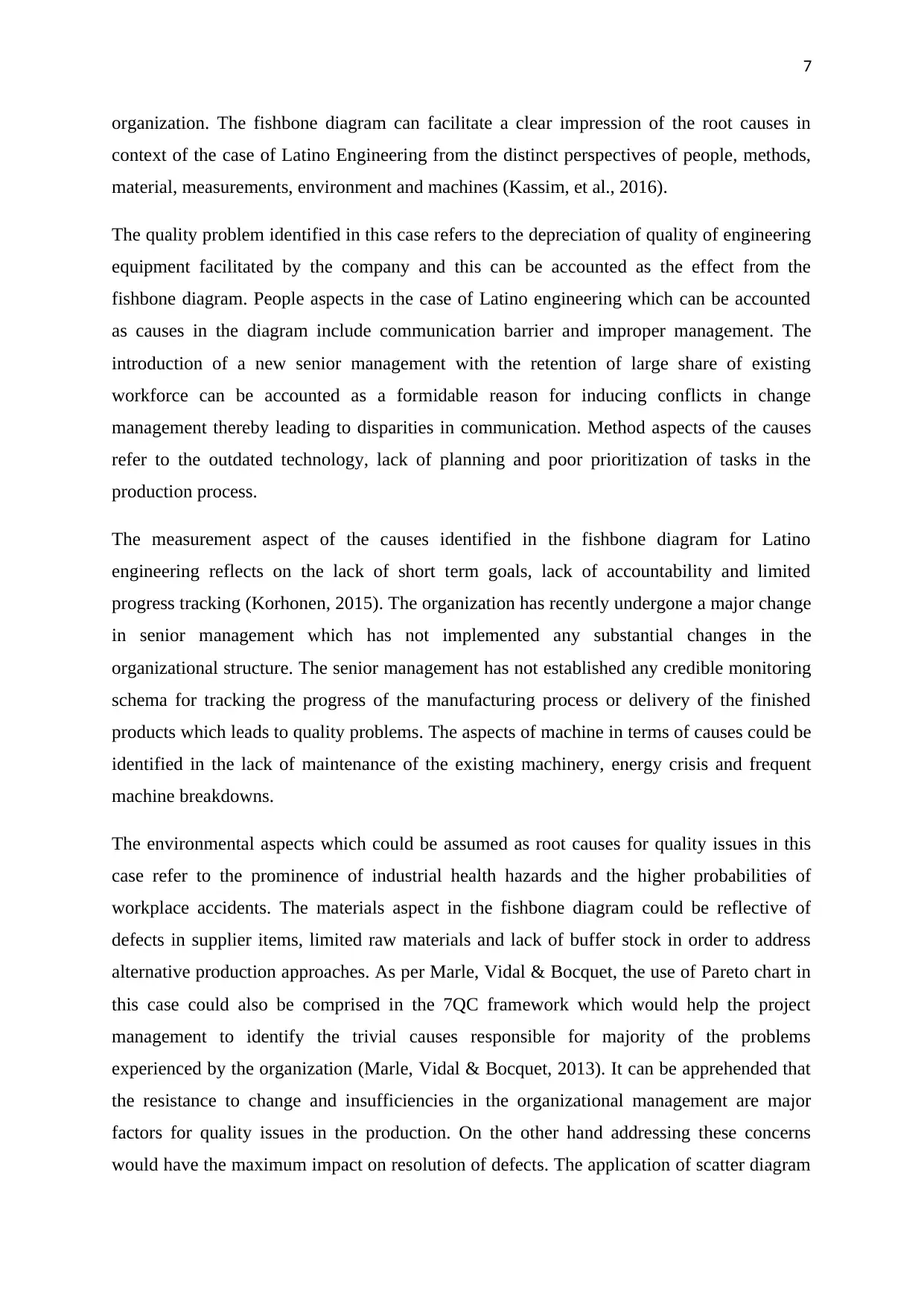
7
organization. The fishbone diagram can facilitate a clear impression of the root causes in
context of the case of Latino Engineering from the distinct perspectives of people, methods,
material, measurements, environment and machines (Kassim, et al., 2016).
The quality problem identified in this case refers to the depreciation of quality of engineering
equipment facilitated by the company and this can be accounted as the effect from the
fishbone diagram. People aspects in the case of Latino engineering which can be accounted
as causes in the diagram include communication barrier and improper management. The
introduction of a new senior management with the retention of large share of existing
workforce can be accounted as a formidable reason for inducing conflicts in change
management thereby leading to disparities in communication. Method aspects of the causes
refer to the outdated technology, lack of planning and poor prioritization of tasks in the
production process.
The measurement aspect of the causes identified in the fishbone diagram for Latino
engineering reflects on the lack of short term goals, lack of accountability and limited
progress tracking (Korhonen, 2015). The organization has recently undergone a major change
in senior management which has not implemented any substantial changes in the
organizational structure. The senior management has not established any credible monitoring
schema for tracking the progress of the manufacturing process or delivery of the finished
products which leads to quality problems. The aspects of machine in terms of causes could be
identified in the lack of maintenance of the existing machinery, energy crisis and frequent
machine breakdowns.
The environmental aspects which could be assumed as root causes for quality issues in this
case refer to the prominence of industrial health hazards and the higher probabilities of
workplace accidents. The materials aspect in the fishbone diagram could be reflective of
defects in supplier items, limited raw materials and lack of buffer stock in order to address
alternative production approaches. As per Marle, Vidal & Bocquet, the use of Pareto chart in
this case could also be comprised in the 7QC framework which would help the project
management to identify the trivial causes responsible for majority of the problems
experienced by the organization (Marle, Vidal & Bocquet, 2013). It can be apprehended that
the resistance to change and insufficiencies in the organizational management are major
factors for quality issues in the production. On the other hand addressing these concerns
would have the maximum impact on resolution of defects. The application of scatter diagram
organization. The fishbone diagram can facilitate a clear impression of the root causes in
context of the case of Latino Engineering from the distinct perspectives of people, methods,
material, measurements, environment and machines (Kassim, et al., 2016).
The quality problem identified in this case refers to the depreciation of quality of engineering
equipment facilitated by the company and this can be accounted as the effect from the
fishbone diagram. People aspects in the case of Latino engineering which can be accounted
as causes in the diagram include communication barrier and improper management. The
introduction of a new senior management with the retention of large share of existing
workforce can be accounted as a formidable reason for inducing conflicts in change
management thereby leading to disparities in communication. Method aspects of the causes
refer to the outdated technology, lack of planning and poor prioritization of tasks in the
production process.
The measurement aspect of the causes identified in the fishbone diagram for Latino
engineering reflects on the lack of short term goals, lack of accountability and limited
progress tracking (Korhonen, 2015). The organization has recently undergone a major change
in senior management which has not implemented any substantial changes in the
organizational structure. The senior management has not established any credible monitoring
schema for tracking the progress of the manufacturing process or delivery of the finished
products which leads to quality problems. The aspects of machine in terms of causes could be
identified in the lack of maintenance of the existing machinery, energy crisis and frequent
machine breakdowns.
The environmental aspects which could be assumed as root causes for quality issues in this
case refer to the prominence of industrial health hazards and the higher probabilities of
workplace accidents. The materials aspect in the fishbone diagram could be reflective of
defects in supplier items, limited raw materials and lack of buffer stock in order to address
alternative production approaches. As per Marle, Vidal & Bocquet, the use of Pareto chart in
this case could also be comprised in the 7QC framework which would help the project
management to identify the trivial causes responsible for majority of the problems
experienced by the organization (Marle, Vidal & Bocquet, 2013). It can be apprehended that
the resistance to change and insufficiencies in the organizational management are major
factors for quality issues in the production. On the other hand addressing these concerns
would have the maximum impact on resolution of defects. The application of scatter diagram
Paraphrase This Document
Need a fresh take? Get an instant paraphrase of this document with our AI Paraphraser
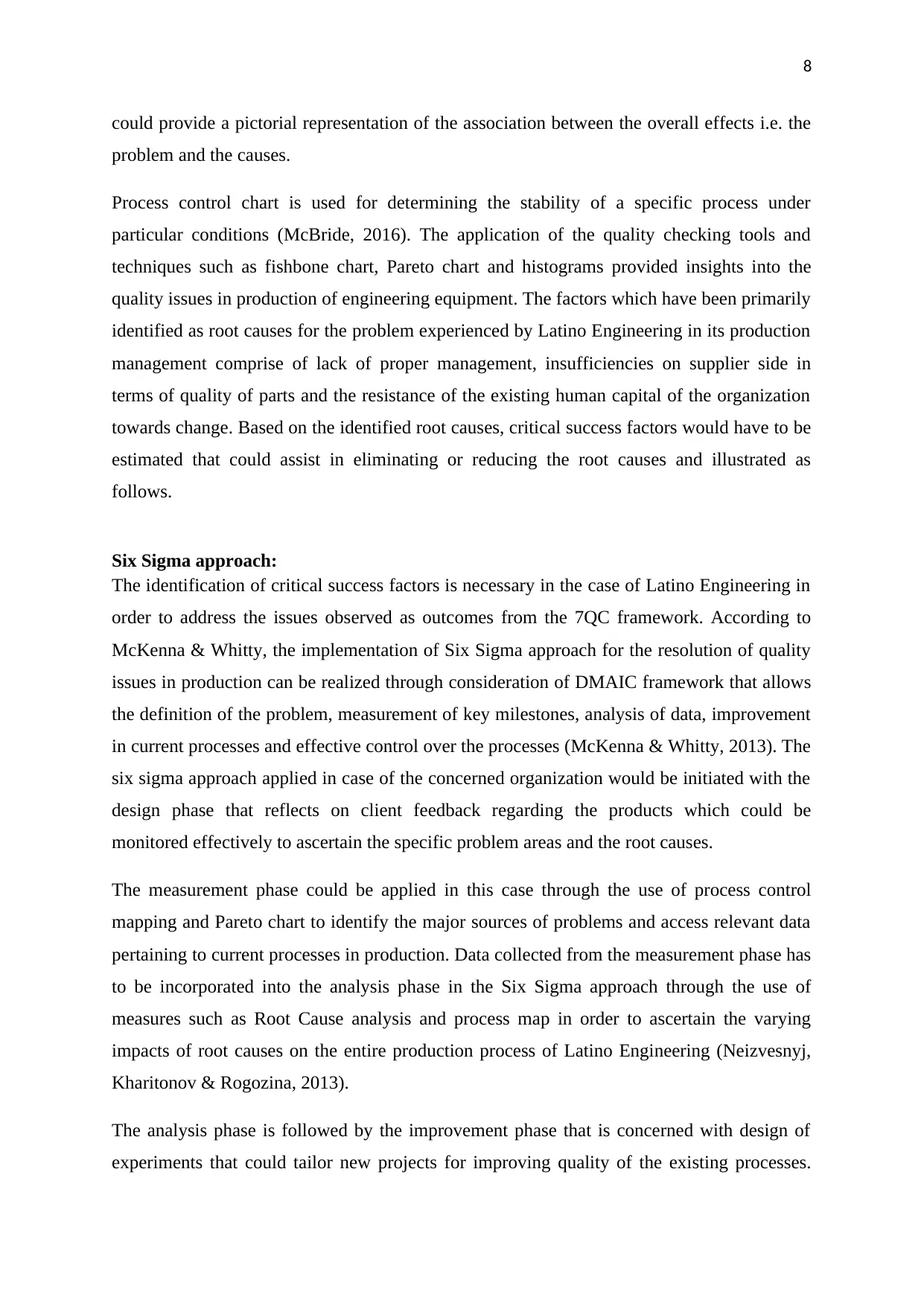
8
could provide a pictorial representation of the association between the overall effects i.e. the
problem and the causes.
Process control chart is used for determining the stability of a specific process under
particular conditions (McBride, 2016). The application of the quality checking tools and
techniques such as fishbone chart, Pareto chart and histograms provided insights into the
quality issues in production of engineering equipment. The factors which have been primarily
identified as root causes for the problem experienced by Latino Engineering in its production
management comprise of lack of proper management, insufficiencies on supplier side in
terms of quality of parts and the resistance of the existing human capital of the organization
towards change. Based on the identified root causes, critical success factors would have to be
estimated that could assist in eliminating or reducing the root causes and illustrated as
follows.
Six Sigma approach:
The identification of critical success factors is necessary in the case of Latino Engineering in
order to address the issues observed as outcomes from the 7QC framework. According to
McKenna & Whitty, the implementation of Six Sigma approach for the resolution of quality
issues in production can be realized through consideration of DMAIC framework that allows
the definition of the problem, measurement of key milestones, analysis of data, improvement
in current processes and effective control over the processes (McKenna & Whitty, 2013). The
six sigma approach applied in case of the concerned organization would be initiated with the
design phase that reflects on client feedback regarding the products which could be
monitored effectively to ascertain the specific problem areas and the root causes.
The measurement phase could be applied in this case through the use of process control
mapping and Pareto chart to identify the major sources of problems and access relevant data
pertaining to current processes in production. Data collected from the measurement phase has
to be incorporated into the analysis phase in the Six Sigma approach through the use of
measures such as Root Cause analysis and process map in order to ascertain the varying
impacts of root causes on the entire production process of Latino Engineering (Neizvesnyj,
Kharitonov & Rogozina, 2013).
The analysis phase is followed by the improvement phase that is concerned with design of
experiments that could tailor new projects for improving quality of the existing processes.
could provide a pictorial representation of the association between the overall effects i.e. the
problem and the causes.
Process control chart is used for determining the stability of a specific process under
particular conditions (McBride, 2016). The application of the quality checking tools and
techniques such as fishbone chart, Pareto chart and histograms provided insights into the
quality issues in production of engineering equipment. The factors which have been primarily
identified as root causes for the problem experienced by Latino Engineering in its production
management comprise of lack of proper management, insufficiencies on supplier side in
terms of quality of parts and the resistance of the existing human capital of the organization
towards change. Based on the identified root causes, critical success factors would have to be
estimated that could assist in eliminating or reducing the root causes and illustrated as
follows.
Six Sigma approach:
The identification of critical success factors is necessary in the case of Latino Engineering in
order to address the issues observed as outcomes from the 7QC framework. According to
McKenna & Whitty, the implementation of Six Sigma approach for the resolution of quality
issues in production can be realized through consideration of DMAIC framework that allows
the definition of the problem, measurement of key milestones, analysis of data, improvement
in current processes and effective control over the processes (McKenna & Whitty, 2013). The
six sigma approach applied in case of the concerned organization would be initiated with the
design phase that reflects on client feedback regarding the products which could be
monitored effectively to ascertain the specific problem areas and the root causes.
The measurement phase could be applied in this case through the use of process control
mapping and Pareto chart to identify the major sources of problems and access relevant data
pertaining to current processes in production. Data collected from the measurement phase has
to be incorporated into the analysis phase in the Six Sigma approach through the use of
measures such as Root Cause analysis and process map in order to ascertain the varying
impacts of root causes on the entire production process of Latino Engineering (Neizvesnyj,
Kharitonov & Rogozina, 2013).
The analysis phase is followed by the improvement phase that is concerned with design of
experiments that could tailor new projects for improving quality of the existing processes.
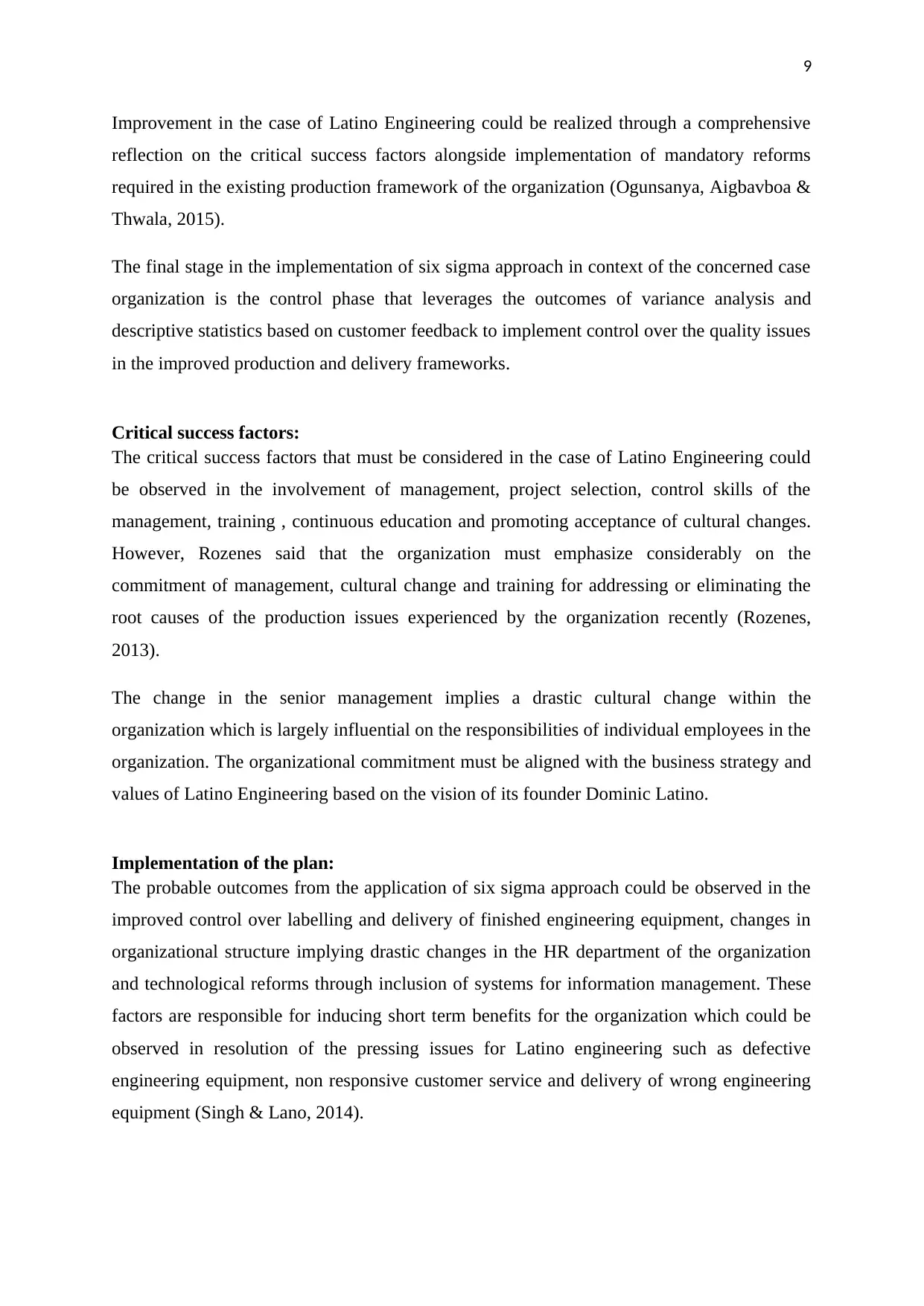
9
Improvement in the case of Latino Engineering could be realized through a comprehensive
reflection on the critical success factors alongside implementation of mandatory reforms
required in the existing production framework of the organization (Ogunsanya, Aigbavboa &
Thwala, 2015).
The final stage in the implementation of six sigma approach in context of the concerned case
organization is the control phase that leverages the outcomes of variance analysis and
descriptive statistics based on customer feedback to implement control over the quality issues
in the improved production and delivery frameworks.
Critical success factors:
The critical success factors that must be considered in the case of Latino Engineering could
be observed in the involvement of management, project selection, control skills of the
management, training , continuous education and promoting acceptance of cultural changes.
However, Rozenes said that the organization must emphasize considerably on the
commitment of management, cultural change and training for addressing or eliminating the
root causes of the production issues experienced by the organization recently (Rozenes,
2013).
The change in the senior management implies a drastic cultural change within the
organization which is largely influential on the responsibilities of individual employees in the
organization. The organizational commitment must be aligned with the business strategy and
values of Latino Engineering based on the vision of its founder Dominic Latino.
Implementation of the plan:
The probable outcomes from the application of six sigma approach could be observed in the
improved control over labelling and delivery of finished engineering equipment, changes in
organizational structure implying drastic changes in the HR department of the organization
and technological reforms through inclusion of systems for information management. These
factors are responsible for inducing short term benefits for the organization which could be
observed in resolution of the pressing issues for Latino engineering such as defective
engineering equipment, non responsive customer service and delivery of wrong engineering
equipment (Singh & Lano, 2014).
Improvement in the case of Latino Engineering could be realized through a comprehensive
reflection on the critical success factors alongside implementation of mandatory reforms
required in the existing production framework of the organization (Ogunsanya, Aigbavboa &
Thwala, 2015).
The final stage in the implementation of six sigma approach in context of the concerned case
organization is the control phase that leverages the outcomes of variance analysis and
descriptive statistics based on customer feedback to implement control over the quality issues
in the improved production and delivery frameworks.
Critical success factors:
The critical success factors that must be considered in the case of Latino Engineering could
be observed in the involvement of management, project selection, control skills of the
management, training , continuous education and promoting acceptance of cultural changes.
However, Rozenes said that the organization must emphasize considerably on the
commitment of management, cultural change and training for addressing or eliminating the
root causes of the production issues experienced by the organization recently (Rozenes,
2013).
The change in the senior management implies a drastic cultural change within the
organization which is largely influential on the responsibilities of individual employees in the
organization. The organizational commitment must be aligned with the business strategy and
values of Latino Engineering based on the vision of its founder Dominic Latino.
Implementation of the plan:
The probable outcomes from the application of six sigma approach could be observed in the
improved control over labelling and delivery of finished engineering equipment, changes in
organizational structure implying drastic changes in the HR department of the organization
and technological reforms through inclusion of systems for information management. These
factors are responsible for inducing short term benefits for the organization which could be
observed in resolution of the pressing issues for Latino engineering such as defective
engineering equipment, non responsive customer service and delivery of wrong engineering
equipment (Singh & Lano, 2014).
⊘ This is a preview!⊘
Do you want full access?
Subscribe today to unlock all pages.

Trusted by 1+ million students worldwide
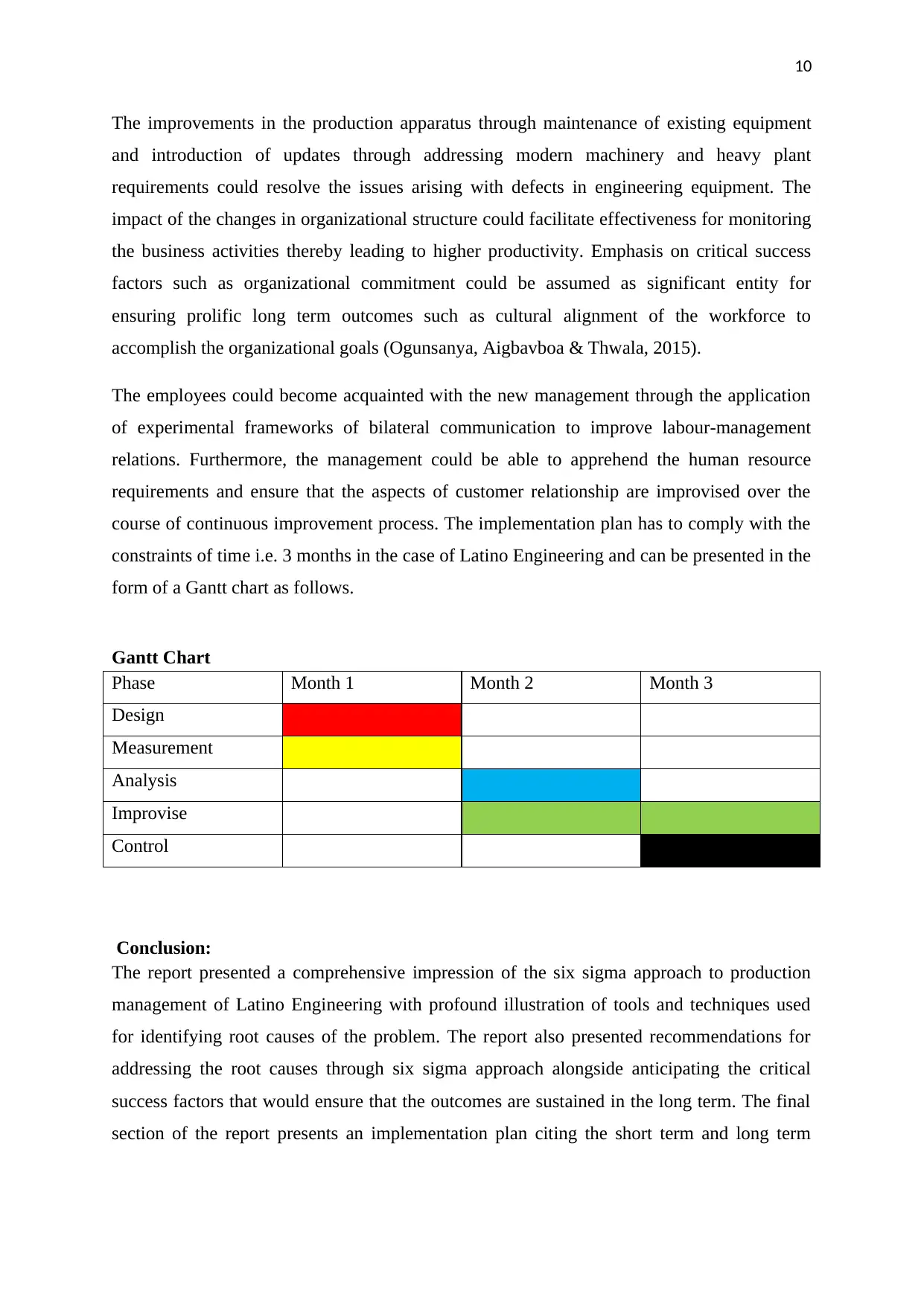
10
The improvements in the production apparatus through maintenance of existing equipment
and introduction of updates through addressing modern machinery and heavy plant
requirements could resolve the issues arising with defects in engineering equipment. The
impact of the changes in organizational structure could facilitate effectiveness for monitoring
the business activities thereby leading to higher productivity. Emphasis on critical success
factors such as organizational commitment could be assumed as significant entity for
ensuring prolific long term outcomes such as cultural alignment of the workforce to
accomplish the organizational goals (Ogunsanya, Aigbavboa & Thwala, 2015).
The employees could become acquainted with the new management through the application
of experimental frameworks of bilateral communication to improve labour-management
relations. Furthermore, the management could be able to apprehend the human resource
requirements and ensure that the aspects of customer relationship are improvised over the
course of continuous improvement process. The implementation plan has to comply with the
constraints of time i.e. 3 months in the case of Latino Engineering and can be presented in the
form of a Gantt chart as follows.
Gantt Chart
Phase Month 1 Month 2 Month 3
Design
Measurement
Analysis
Improvise
Control
Conclusion:
The report presented a comprehensive impression of the six sigma approach to production
management of Latino Engineering with profound illustration of tools and techniques used
for identifying root causes of the problem. The report also presented recommendations for
addressing the root causes through six sigma approach alongside anticipating the critical
success factors that would ensure that the outcomes are sustained in the long term. The final
section of the report presents an implementation plan citing the short term and long term
The improvements in the production apparatus through maintenance of existing equipment
and introduction of updates through addressing modern machinery and heavy plant
requirements could resolve the issues arising with defects in engineering equipment. The
impact of the changes in organizational structure could facilitate effectiveness for monitoring
the business activities thereby leading to higher productivity. Emphasis on critical success
factors such as organizational commitment could be assumed as significant entity for
ensuring prolific long term outcomes such as cultural alignment of the workforce to
accomplish the organizational goals (Ogunsanya, Aigbavboa & Thwala, 2015).
The employees could become acquainted with the new management through the application
of experimental frameworks of bilateral communication to improve labour-management
relations. Furthermore, the management could be able to apprehend the human resource
requirements and ensure that the aspects of customer relationship are improvised over the
course of continuous improvement process. The implementation plan has to comply with the
constraints of time i.e. 3 months in the case of Latino Engineering and can be presented in the
form of a Gantt chart as follows.
Gantt Chart
Phase Month 1 Month 2 Month 3
Design
Measurement
Analysis
Improvise
Control
Conclusion:
The report presented a comprehensive impression of the six sigma approach to production
management of Latino Engineering with profound illustration of tools and techniques used
for identifying root causes of the problem. The report also presented recommendations for
addressing the root causes through six sigma approach alongside anticipating the critical
success factors that would ensure that the outcomes are sustained in the long term. The final
section of the report presents an implementation plan citing the short term and long term
Paraphrase This Document
Need a fresh take? Get an instant paraphrase of this document with our AI Paraphraser
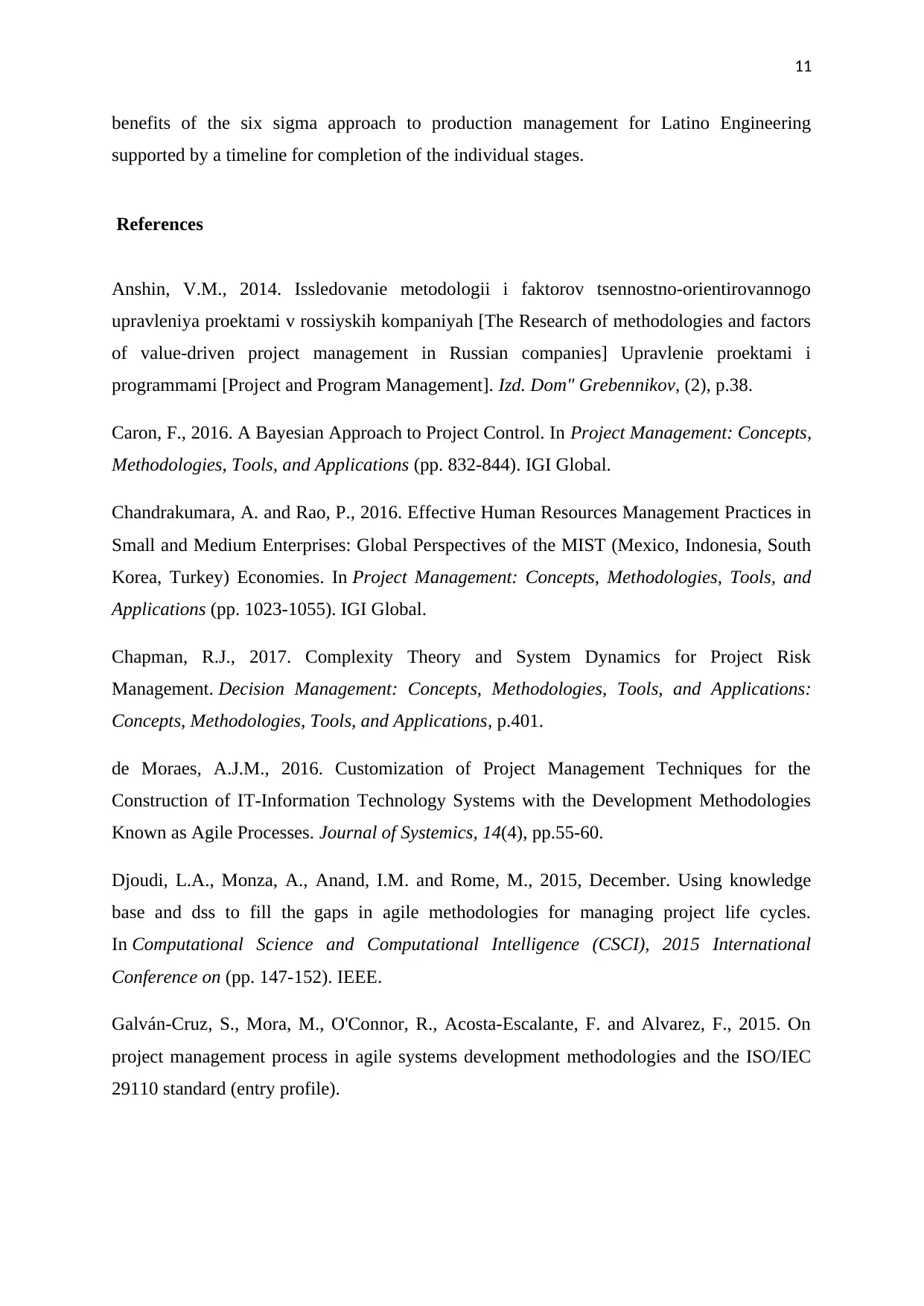
11
benefits of the six sigma approach to production management for Latino Engineering
supported by a timeline for completion of the individual stages.
References
Anshin, V.M., 2014. Issledovanie metodologii i faktorov tsennostno-orientirovannogo
upravleniya proektami v rossiyskih kompaniyah [The Research of methodologies and factors
of value-driven project management in Russian companies] Upravlenie proektami i
programmami [Project and Program Management]. Izd. Dom" Grebennikov, (2), p.38.
Caron, F., 2016. A Bayesian Approach to Project Control. In Project Management: Concepts,
Methodologies, Tools, and Applications (pp. 832-844). IGI Global.
Chandrakumara, A. and Rao, P., 2016. Effective Human Resources Management Practices in
Small and Medium Enterprises: Global Perspectives of the MIST (Mexico, Indonesia, South
Korea, Turkey) Economies. In Project Management: Concepts, Methodologies, Tools, and
Applications (pp. 1023-1055). IGI Global.
Chapman, R.J., 2017. Complexity Theory and System Dynamics for Project Risk
Management. Decision Management: Concepts, Methodologies, Tools, and Applications:
Concepts, Methodologies, Tools, and Applications, p.401.
de Moraes, A.J.M., 2016. Customization of Project Management Techniques for the
Construction of IT-Information Technology Systems with the Development Methodologies
Known as Agile Processes. Journal of Systemics, 14(4), pp.55-60.
Djoudi, L.A., Monza, A., Anand, I.M. and Rome, M., 2015, December. Using knowledge
base and dss to fill the gaps in agile methodologies for managing project life cycles.
In Computational Science and Computational Intelligence (CSCI), 2015 International
Conference on (pp. 147-152). IEEE.
Galván-Cruz, S., Mora, M., O'Connor, R., Acosta-Escalante, F. and Alvarez, F., 2015. On
project management process in agile systems development methodologies and the ISO/IEC
29110 standard (entry profile).
benefits of the six sigma approach to production management for Latino Engineering
supported by a timeline for completion of the individual stages.
References
Anshin, V.M., 2014. Issledovanie metodologii i faktorov tsennostno-orientirovannogo
upravleniya proektami v rossiyskih kompaniyah [The Research of methodologies and factors
of value-driven project management in Russian companies] Upravlenie proektami i
programmami [Project and Program Management]. Izd. Dom" Grebennikov, (2), p.38.
Caron, F., 2016. A Bayesian Approach to Project Control. In Project Management: Concepts,
Methodologies, Tools, and Applications (pp. 832-844). IGI Global.
Chandrakumara, A. and Rao, P., 2016. Effective Human Resources Management Practices in
Small and Medium Enterprises: Global Perspectives of the MIST (Mexico, Indonesia, South
Korea, Turkey) Economies. In Project Management: Concepts, Methodologies, Tools, and
Applications (pp. 1023-1055). IGI Global.
Chapman, R.J., 2017. Complexity Theory and System Dynamics for Project Risk
Management. Decision Management: Concepts, Methodologies, Tools, and Applications:
Concepts, Methodologies, Tools, and Applications, p.401.
de Moraes, A.J.M., 2016. Customization of Project Management Techniques for the
Construction of IT-Information Technology Systems with the Development Methodologies
Known as Agile Processes. Journal of Systemics, 14(4), pp.55-60.
Djoudi, L.A., Monza, A., Anand, I.M. and Rome, M., 2015, December. Using knowledge
base and dss to fill the gaps in agile methodologies for managing project life cycles.
In Computational Science and Computational Intelligence (CSCI), 2015 International
Conference on (pp. 147-152). IEEE.
Galván-Cruz, S., Mora, M., O'Connor, R., Acosta-Escalante, F. and Alvarez, F., 2015. On
project management process in agile systems development methodologies and the ISO/IEC
29110 standard (entry profile).
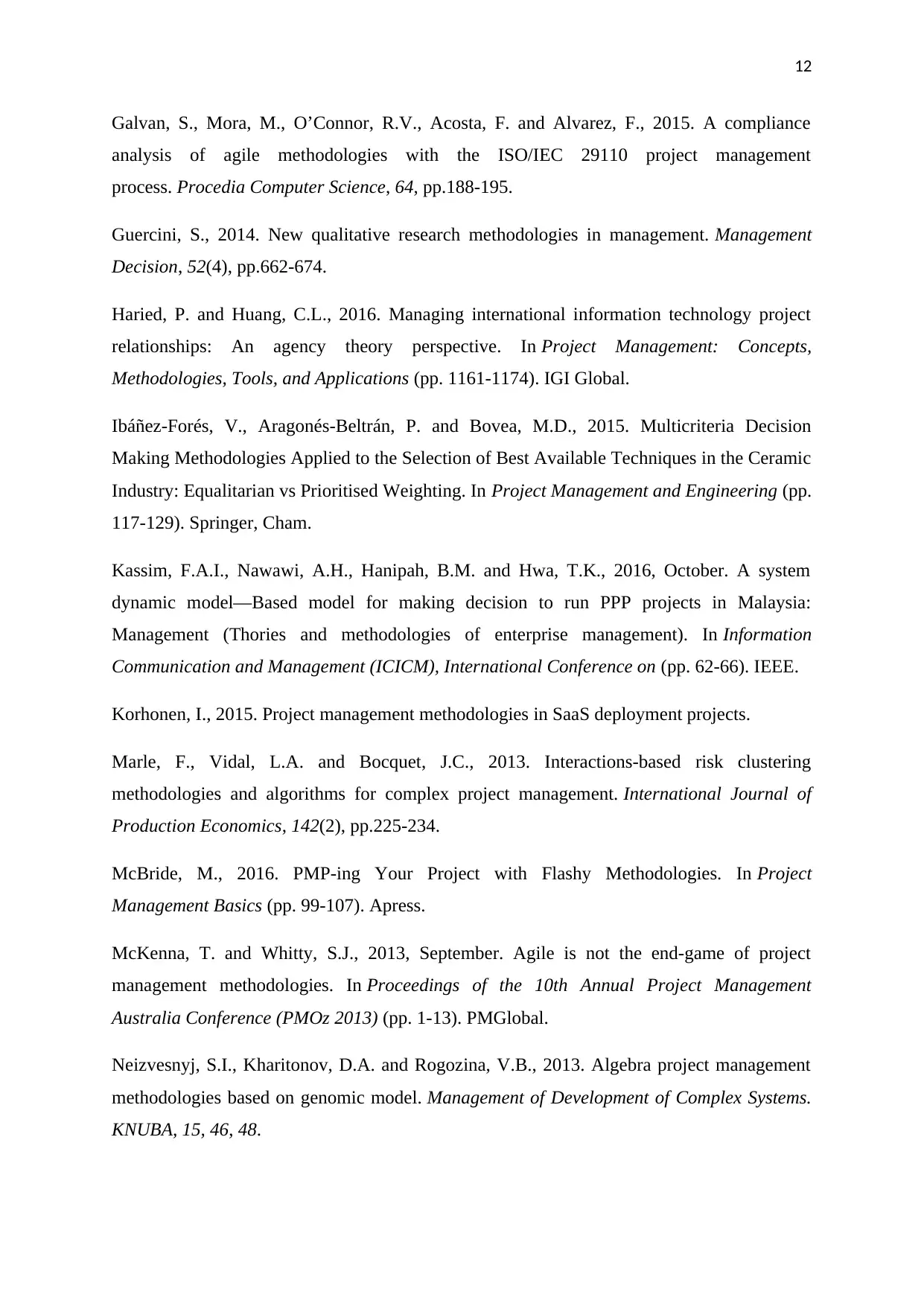
12
Galvan, S., Mora, M., O’Connor, R.V., Acosta, F. and Alvarez, F., 2015. A compliance
analysis of agile methodologies with the ISO/IEC 29110 project management
process. Procedia Computer Science, 64, pp.188-195.
Guercini, S., 2014. New qualitative research methodologies in management. Management
Decision, 52(4), pp.662-674.
Haried, P. and Huang, C.L., 2016. Managing international information technology project
relationships: An agency theory perspective. In Project Management: Concepts,
Methodologies, Tools, and Applications (pp. 1161-1174). IGI Global.
Ibáñez-Forés, V., Aragonés-Beltrán, P. and Bovea, M.D., 2015. Multicriteria Decision
Making Methodologies Applied to the Selection of Best Available Techniques in the Ceramic
Industry: Equalitarian vs Prioritised Weighting. In Project Management and Engineering (pp.
117-129). Springer, Cham.
Kassim, F.A.I., Nawawi, A.H., Hanipah, B.M. and Hwa, T.K., 2016, October. A system
dynamic model—Based model for making decision to run PPP projects in Malaysia:
Management (Thories and methodologies of enterprise management). In Information
Communication and Management (ICICM), International Conference on (pp. 62-66). IEEE.
Korhonen, I., 2015. Project management methodologies in SaaS deployment projects.
Marle, F., Vidal, L.A. and Bocquet, J.C., 2013. Interactions-based risk clustering
methodologies and algorithms for complex project management. International Journal of
Production Economics, 142(2), pp.225-234.
McBride, M., 2016. PMP-ing Your Project with Flashy Methodologies. In Project
Management Basics (pp. 99-107). Apress.
McKenna, T. and Whitty, S.J., 2013, September. Agile is not the end-game of project
management methodologies. In Proceedings of the 10th Annual Project Management
Australia Conference (PMOz 2013) (pp. 1-13). PMGlobal.
Neizvesnyj, S.I., Kharitonov, D.A. and Rogozina, V.B., 2013. Algebra project management
methodologies based on genomic model. Management of Development of Complex Systems.
KNUBA, 15, 46, 48.
Galvan, S., Mora, M., O’Connor, R.V., Acosta, F. and Alvarez, F., 2015. A compliance
analysis of agile methodologies with the ISO/IEC 29110 project management
process. Procedia Computer Science, 64, pp.188-195.
Guercini, S., 2014. New qualitative research methodologies in management. Management
Decision, 52(4), pp.662-674.
Haried, P. and Huang, C.L., 2016. Managing international information technology project
relationships: An agency theory perspective. In Project Management: Concepts,
Methodologies, Tools, and Applications (pp. 1161-1174). IGI Global.
Ibáñez-Forés, V., Aragonés-Beltrán, P. and Bovea, M.D., 2015. Multicriteria Decision
Making Methodologies Applied to the Selection of Best Available Techniques in the Ceramic
Industry: Equalitarian vs Prioritised Weighting. In Project Management and Engineering (pp.
117-129). Springer, Cham.
Kassim, F.A.I., Nawawi, A.H., Hanipah, B.M. and Hwa, T.K., 2016, October. A system
dynamic model—Based model for making decision to run PPP projects in Malaysia:
Management (Thories and methodologies of enterprise management). In Information
Communication and Management (ICICM), International Conference on (pp. 62-66). IEEE.
Korhonen, I., 2015. Project management methodologies in SaaS deployment projects.
Marle, F., Vidal, L.A. and Bocquet, J.C., 2013. Interactions-based risk clustering
methodologies and algorithms for complex project management. International Journal of
Production Economics, 142(2), pp.225-234.
McBride, M., 2016. PMP-ing Your Project with Flashy Methodologies. In Project
Management Basics (pp. 99-107). Apress.
McKenna, T. and Whitty, S.J., 2013, September. Agile is not the end-game of project
management methodologies. In Proceedings of the 10th Annual Project Management
Australia Conference (PMOz 2013) (pp. 1-13). PMGlobal.
Neizvesnyj, S.I., Kharitonov, D.A. and Rogozina, V.B., 2013. Algebra project management
methodologies based on genomic model. Management of Development of Complex Systems.
KNUBA, 15, 46, 48.
⊘ This is a preview!⊘
Do you want full access?
Subscribe today to unlock all pages.

Trusted by 1+ million students worldwide
1 out of 13
Related Documents
Your All-in-One AI-Powered Toolkit for Academic Success.
+13062052269
info@desklib.com
Available 24*7 on WhatsApp / Email
![[object Object]](/_next/static/media/star-bottom.7253800d.svg)
Unlock your academic potential
Copyright © 2020–2025 A2Z Services. All Rights Reserved. Developed and managed by ZUCOL.




